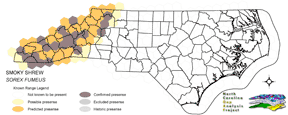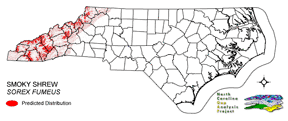
| Taxa: |
| Order: |
| Family: |
| Mammalia |
| Insectivora |
| Soricidae |
| NatureServe Global Rank: |
| NatureServe State (NC) Rank: |
| G5 |
| S4 |
| Federal Status: |
| NC State Status: |
| --- |
| --- |


| Land Unit |
| US Fish & Wildlife Service |
| US Forest Service |
| US National Park Service |
| US Department of Defense |
| NC State Parks |
| NC University System |
| NC Wildlife Res. Com. |
| NC Forest Service |
| NC Div. of Coastal Mgmt. |
| Local Governments |
| Non-Governmental Org. |
| Other Public Lands |
| Private Lands |
| GAP Status 1-2 |
| All Protected Lands |
| Statewide |
| Hectares |
| 0.00 |
| 166,917.69 |
| 24.48 |
| 68,958.45 |
| 2,356.65 |
| 49.50 |
| 3,448.89 |
| 696.66 |
| 0.00 |
| 4,620.33 |
| 4,696.83 |
| 8.10 |
| 307,507.23 |
| 96,943.92 |
| 251,624.31 |
| 559,284.81 |
| Acres |
| 0.00 |
| 412,462.51 |
| 60.49 |
| 170,400.01 |
| 5,823.41 |
| 122.32 |
| 8,522.39 |
| 2,471.70 |
| 0.00 |
| 11,417.08 |
| 11,606.12 |
| 20.02 |
| 759,866.77 |
| 240,303.81 |
| 622,527.30 |
| 1,382,772.81 |
| % of Dist. on |
| Prot. Lands |
| 0.0 % |
| 66.3 % |
| < 0.1 % |
| 27.4 % |
| 0.9 % |
| < 0.1 % |
| 1.4 % |
| 0.3 % |
| 0.0 % |
| 1.8 % |
| 1.8 % |
| < 0.1 % |
| 0.0 % |
| 38.5 % |
| ----- |
| ----- |
| % of Dist. on |
| All Lands |
| 0.0 % |
| 29.8 % |
| < 0.1 % |
| 12.3 % |
| 0.4 % |
| < 0.1 % |
| 0.6 % |
| 0.1 % |
| 0.0 % |
| 0.8 % |
| 0.8 % |
| < 0.1 % |
| 55.0 % |
| 17.3 % |
| ----- |
| ----- |
|
Found throughout the mountains of Western North Carolina in localized populations (Webster et al. 1985). Within the region, the shrew appears to be most plentiful at mid and high elevations (Linzey and Linzey 1971). It can be locally abundant. Resides in dense, cool, moist forests. Often found along mountain creeks, but essentially only restricted to cool, moist habitat conditions (Linzey and Linzey 1971). Seeks shelter in thick leaf litter or humus, moss-covered rock talus and decaying logs and stumps (Webster et al. 1985). NATURE SERVE GLOBAL HABITAT COMMENTS: Most abundant in damp wooded areas. Nest sites are beneath stumps, rotted logs, or rocks. |
| Code | Name | Description | NC Natural Heritage Program Equivalent |
| 384 | Piedmont/Mountain Mixed Bottomland Hardwood Forests | Includes temporarily to seasonally forests dominated by hardwood species. Hardwoods include sweetgum, red maple, sycamore which co-occur in a mosaic of bottomland and levee positions. Includes alluvial hardwood forests in the mountains. Hemlock and white pine may occur as inclusions, but are generally mapped separately. | Piedmont/Mountain Alluvial Forest, Piedmont/Mountain Levee Forest |
| 517 | Hemlock Floodplain Forest | Alluvial forest with hemlock and/or white pine in mountains and western piedmont. Hydrology is generally temporarily to seasonally flooded. | Canada Hemlock Forest |
| 521 | Spruce/Fir Forest | High Elevation Frazer-Fir - Red Spruce, Red Spruce and Red-Spruce-Yellow Birch Forests. Tree densities included here include both woodland to forest density. Highly intermixed with Northern Hardwoods, Grassy Balds, and Shrub Balds. | Red Spruce--Fraser Fir Forest, Fraser Fir Forest |
| 522 | Northern Hardwoods | High Elevation forests including yellow birch, American beech, and yellow buckeye. Includes forests with Hemlock and Yellow Birch. | Northern Hardwoods Forest, Boulderfield Forest |
| 525 | Appalachian Oak Forest | A variety of oak forest types including Black, White, Scarlet Oaks in dry to mesic situations. Includes forests historically co-dominated by American Chestnut. | High Elevation Red Oak Forest, Montane White Oak Forest |
| 526 | Appalachian Cove Forest | Mixed Mesophytic forests of the mountains. Includes tuliptree, basswood, yellow buckeye and surgar maple. This class is mapped to include cove forests dominated or co-dominated by hemlock. | Rich Cove Forest, Acidic Cove Forest |
| 527 | Appalachian Hemlock | Upland hemlock forests of the moutains region. Vary from side slopes to steep slope positions. | Canada Hemlock Forest |
| 533 | Appalachian Swamp Forest | Evergreen and deciduous forests with saturated hydrologies. This class may contain a variety of trees species, including hemlock - red maple, pitch pine, and white pine forests. | Swamp Forest-Bog Complex, Southern Appalachian Bog, Southern Appalachian Fen |
| 534 | Appalachian Wet Shrubland/ Herbaceous | Saturated shrubs and herbaceous vegetation. Often mapped as an inclusion in Appalachian Swamp Forest. | Southern Appalachian Bog, Southern Appalachian Fen |
|
Hamilton, W.J. 1940. The biology of the smoky shrew (Sorex fumeus fumeus Miller). Zoologica 25(4):473-492.
George, S. B. 1988. Systematics, historical biogeography, and evolution of the genus SOREX. J. Mammalogy 69:443-461. Jackson, H. H. T. 1928. A taxonomic review of the American long-tailed shrews (genera SOREX and MICROSOREX). North American Fauna 51:1-238. Churchfield, S. 1992. The Natural History of Shrews. Cornell University Press, Ithaca, New York. 192 pp. Jannett, F. J., Jr., and R. J. Oehlenschlager. 1994. Range extension and first Minnesota records of the smoky shrew Sorex fumeus. Am. Midl. Nat. 131:364-365. Linzey, Alicia V., & Donald W. Linzey. 1971. Mammals of the Great Smoky Mountains National Park. The University of Ten- nessee Press, Knoxville, Tennessee. 114 p. Banfield, A.W.F. 1974. The mammals of Canada. University of Toronto Press, Toronto. Godin, A.J. 1977. Wild Mammals of New England. Johns Hopkins University Press, Baltimore. 304 pp. Owen, J.G. 1984. Sorex fumeus. Am. Soc. Mamm., Mammalian Species No. 215. 8 pp. Hamilton, William J., Jr., and John O. Whitaker, Jr. 1979. Mammals of the eastern United States. Cornell Univ. Press, Ithaca, New York. 346 pp. Hall, E. R. 1981. The Mammals of North America. Second edition. 2 Volumes. John Wiley and Sons, New York, New York. Baker, Rollin H. 1983. Michigan mammals. Michigan State University Press. 642 pp. van Zyll de Jong, C. G. 1983. Handbook of Canadian Mammals. 1. Marsupials and insectivores. Nat. Mus. Canada, Ottawa. 212 pp. Webster, W. D., J. F. Parnell and W. C. Biggs Jr. 1985. Mammals of the Carolinas, Virginia, and Maryland. The University of North Carolina Press, Chapel Hill, NC. |
For more information please contact them at:
NC-GAP Analysis Project
Dept. of Zoology, NCSU
Campus Box 7617
Raleigh, NC 27695-7617
(919) 513-2853
www.basic.ncsu.edu/ncgap